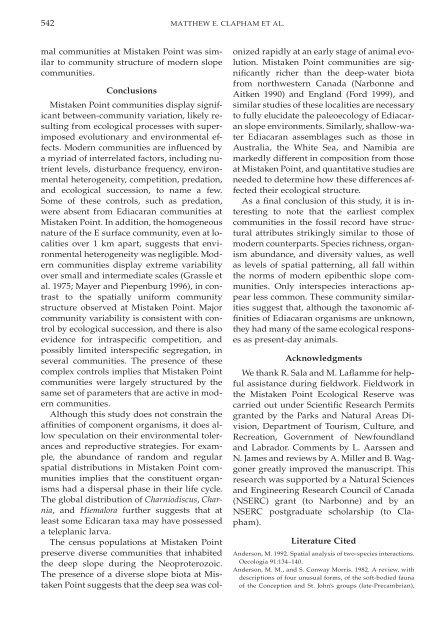Paleoecology of the oldest known animal communities: Ediacaran ...
Paleoecology of the oldest known animal communities: Ediacaran ...
Paleoecology of the oldest known animal communities: Ediacaran ...
You also want an ePaper? Increase the reach of your titles
YUMPU automatically turns print PDFs into web optimized ePapers that Google loves.
542 MATTHEW E. CLAPHAM ET AL.<br />
mal <strong>communities</strong> at Mistaken Point was similar<br />
to community structure <strong>of</strong> modern slope<br />
<strong>communities</strong>.<br />
Conclusions<br />
Mistaken Point <strong>communities</strong> display significant<br />
between-community variation, likely resulting<br />
from ecological processes with superimposed<br />
evolutionary and environmental effects.<br />
Modern <strong>communities</strong> are influenced by<br />
a myriad <strong>of</strong> interrelated factors, including nutrient<br />
levels, disturbance frequency, environmental<br />
heterogeneity, competition, predation,<br />
and ecological succession, to name a few.<br />
Some <strong>of</strong> <strong>the</strong>se controls, such as predation,<br />
were absent from <strong>Ediacaran</strong> <strong>communities</strong> at<br />
Mistaken Point. In addition, <strong>the</strong> homogeneous<br />
nature <strong>of</strong> <strong>the</strong> E surface community, even at localities<br />
over 1 km apart, suggests that environmental<br />
heterogeneity was negligible. Modern<br />
<strong>communities</strong> display extreme variability<br />
over small and intermediate scales (Grassle et<br />
al. 1975; Mayer and Piepenburg 1996), in contrast<br />
to <strong>the</strong> spatially uniform community<br />
structure observed at Mistaken Point. Major<br />
community variability is consistent with control<br />
by ecological succession, and <strong>the</strong>re is also<br />
evidence for intraspecific competition, and<br />
possibly limited interspecific segregation, in<br />
several <strong>communities</strong>. The presence <strong>of</strong> <strong>the</strong>se<br />
complex controls implies that Mistaken Point<br />
<strong>communities</strong> were largely structured by <strong>the</strong><br />
same set <strong>of</strong> parameters that are active in modern<br />
<strong>communities</strong>.<br />
Although this study does not constrain <strong>the</strong><br />
affinities <strong>of</strong> component organisms, it does allow<br />
speculation on <strong>the</strong>ir environmental tolerances<br />
and reproductive strategies. For example,<br />
<strong>the</strong> abundance <strong>of</strong> random and regular<br />
spatial distributions in Mistaken Point <strong>communities</strong><br />
implies that <strong>the</strong> constituent organisms<br />
had a dispersal phase in <strong>the</strong>ir life cycle.<br />
The global distribution <strong>of</strong> Charniodiscus, Charnia,<br />
and Hiemalora fur<strong>the</strong>r suggests that at<br />
least some Edicaran taxa may have possessed<br />
a teleplanic larva.<br />
The census populations at Mistaken Point<br />
preserve diverse <strong>communities</strong> that inhabited<br />
<strong>the</strong> deep slope during <strong>the</strong> Neoproterozoic.<br />
The presence <strong>of</strong> a diverse slope biota at Mistaken<br />
Point suggests that <strong>the</strong> deep sea was colonized<br />
rapidly at an early stage <strong>of</strong> <strong>animal</strong> evolution.<br />
Mistaken Point <strong>communities</strong> are significantly<br />
richer than <strong>the</strong> deep-water biota<br />
from northwestern Canada (Narbonne and<br />
Aitken 1990) and England (Ford 1999), and<br />
similar studies <strong>of</strong> <strong>the</strong>se localities are necessary<br />
to fully elucidate <strong>the</strong> paleoecology <strong>of</strong> <strong>Ediacaran</strong><br />
slope environments. Similarly, shallow-water<br />
<strong>Ediacaran</strong> assemblages such as those in<br />
Australia, <strong>the</strong> White Sea, and Namibia are<br />
markedly different in composition from those<br />
at Mistaken Point, and quantitative studies are<br />
needed to determine how <strong>the</strong>se differences affected<br />
<strong>the</strong>ir ecological structure.<br />
As a final conclusion <strong>of</strong> this study, it is interesting<br />
to note that <strong>the</strong> earliest complex<br />
<strong>communities</strong> in <strong>the</strong> fossil record have structural<br />
attributes strikingly similar to those <strong>of</strong><br />
modern counterparts. Species richness, organism<br />
abundance, and diversity values, as well<br />
as levels <strong>of</strong> spatial patterning, all fall within<br />
<strong>the</strong> norms <strong>of</strong> modern epibenthic slope <strong>communities</strong>.<br />
Only interspecies interactions appear<br />
less common. These community similarities<br />
suggest that, although <strong>the</strong> taxonomic affinities<br />
<strong>of</strong> <strong>Ediacaran</strong> organisms are un<strong>known</strong>,<br />
<strong>the</strong>y had many <strong>of</strong> <strong>the</strong> same ecological responses<br />
as present-day <strong>animal</strong>s.<br />
Acknowledgments<br />
We thank R. Sala and M. Laflamme for helpful<br />
assistance during fieldwork. Fieldwork in<br />
<strong>the</strong> Mistaken Point Ecological Reserve was<br />
carried out under Scientific Research Permits<br />
granted by <strong>the</strong> Parks and Natural Areas Division,<br />
Department <strong>of</strong> Tourism, Culture, and<br />
Recreation, Government <strong>of</strong> Newfoundland<br />
and Labrador. Comments by L. Aarssen and<br />
N. James and reviews by A. Miller and B. Waggoner<br />
greatly improved <strong>the</strong> manuscript. This<br />
research was supported by a Natural Sciences<br />
and Engineering Research Council <strong>of</strong> Canada<br />
(NSERC) grant (to Narbonne) and by an<br />
NSERC postgraduate scholarship (to Clapham).<br />
Literature Cited<br />
Anderson, M. 1992. Spatial analysis <strong>of</strong> two-species interactions.<br />
Oecologia 91:134–140.<br />
Anderson, M. M., and S. Conway Morris. 1982. A review, with<br />
descriptions <strong>of</strong> four unusual forms, <strong>of</strong> <strong>the</strong> s<strong>of</strong>t-bodied fauna<br />
<strong>of</strong> <strong>the</strong> Conception and St. John’s groups (late-Precambrian),

















